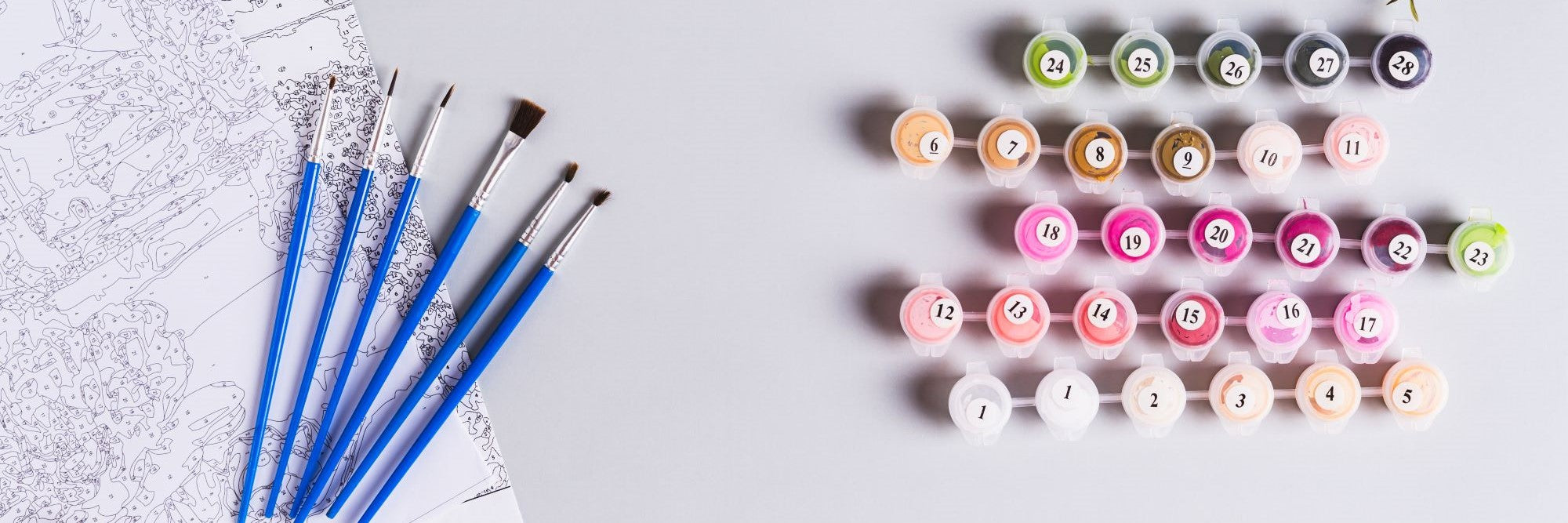Acrylic paint is a beloved medium for artists and hobbyists alike, especially popular in painting project like paint-by-numbers kits or canvas painting due to its vibrant colors and ease of use. However, its quick-drying and water-resistant properties can make accidental spills on clothing a nightmare. In this guide, we’ll explore acrylic paint’s characteristics, and effective methods to remove it from clothes.
Table of content
What is Acrylic Painting?
Acrylic paint is made from pigment suspended in an acrylic polymer emulsion, and it can be used on a variety of surfaces including canvas, wood, paper, and more. Artists often favor acrylics for their adaptability—they can be used in a thick, textured application similar to oils or thinned with water to mimic the transparency of watercolors.
Key Characteristics of Acrylic
- Fast-Drying: Acrylic dries quickly, typically becoming surface-dry within minutes to half an hour, allowing for efficient layering.
- Water-Resistant: Once dry, it forms a waterproof film that resists water dissolution, preserving vibrant colors long-term.
- Strong Adhesion: Bonds well to various surfaces like canvas, wood, and fabric without peeling.
- Solubility in Organic Solvents: Removable with water when wet but requires alcohol, acetone, or similar solvents once dried.These traits make acrylics ideal for art projects but challenging to remove from clothes once dried.
Different Solutions for Immediate Spill and Dried Stain
Due to its quick-drying and water-resistant properties, requires different approaches for immediate spills and dried stains. For fresh spills, prompt action with water and soap can effectively remove the paint. However, once dried, it becomes stubborn, often necessitating specialized solvents or scraping techniques for removal. Understanding these distinctions ensures proper and efficient cleanup.
So how do you get acrylic paint out of clothes? In this guide, we will explore solutions for both wet and dried paint.
How to Remove Acrylic Paint from Clothes After Immediate Spill?
The speed at which you act makes all the difference. Freshly spilled acrylic paint is infinitely easier to remove than dried stains. Here's what to do as soon as the accident happens:
- Act Quickly: The longer paint sits, the harder it becomes to remove. Treat the stain as soon as possible.
- Do Not Rub the Stain: Rubbing pushes the paint deeper into the fabric's fibers. Instead, carefully blot to remove excess paint.
- Identify the Fabric Type: Check the garment tag to determine its material. Delicate fabrics like silk may require special care, while cotton or polyester can withstand more aggressive cleaning.

Now that you've acted promptly, let's ensure you're armed with the right tools.
Materials You’ll Need
Gather these cleaning supplies before you begin removing the acrylic paint stain:
- A plastic spoon or dull knife (for scraping).
- Paper towels or cloth for blotting.
- Cold water.
- Mild dish soap or laundry detergent.
- Rubbing alcohol or acetone (for stubborn or dry stains).
- Soft-bristle brush or old toothbrush. l Clean white rag or sponge.

Step-by-Step Guide to Remove Acrylic Paint From Cloth
Follow these steps to tackle acrylic paint stains on clothes effectively:
Step 1. Scrape Off Excess Paint
If there's still wet paint on the fabric, gently scrape it off using a plastic spoon or blunt knife. Avoid using anything sharp that could damage the fabric. Work from the edges of the stain towards the center to prevent spreading.
Step 2. Rinse the Fabric with Cold Water
Rinse the stained area with cold water as soon as possible. Hold the garment under running water, letting the water flow from the back of the fabric to push the paint out. Avoid using hot water, as this can set the stain.

Step 3. Pre-treat Stain
Create a cleaning solution by mixing a few drops of dish soap or laundry detergent with cold water. Dip a sponge or clean white rag into the solution and gently dab the stained area. Work in small circular motions to lift as much paint as possible. If the stain persists, try using rubbing alcohol or acetone (nail polish remover), testing it first on a hidden area of the fabric to ensure it doesn’t cause discoloration. Use a soft-bristle brush to gently scrub the stain while applying the alcohol or acetone.

Step 4. Wash the Garment
Once the stain has lifted, thoroughly rinse the garment to remove any remaining cleaning solution and paint residue. Then, wash it in the washing machine on a cold setting with your usual detergent. Avoid throwing it in the dryer until you’re certain the stain is gone, as heat can set any remaining paint.

Things to notice during cleaning
When cleaning acrylic on cloth, avoid using hot water, strong acids or alkalis, organic solvents, abrasive tools or harsh chemicals, as they can damage the fabric. We have picked 5 common materials you can obtain in your daily life, and tested the effectiveness of removing the acrylic stain, check the test report here. Additionally, always test any cleaning solutions on a hidden area of the garment first to ensure it won’t cause discoloration or damage.
How to Get Acrylic Paint Out of Fabric When Dried?
Accidentally got dried acrylic on your clothes? While it’s more difficult to remove than wet paint, it’s still possible with some extra effort and patience. Follow these steps to restore your clothing.
Step 1. Scrape and Loosen the Paint
Start by gently scraping off as much dried paint as you can. Use a plastic spoon, butter knife, or similar blunt object to avoid damaging the fabric. Hold the fabric taut and flex it slightly to help crack and loosen the paint. Be thorough but gentle—your goal is to remove as much of the hardened paint as possible before applying any liquids.

Step 2. Pre-Treat the Stain
Next, focus on breaking down the remaining paint. Apply a solvent like rubbing alcohol, acetone (commonly found in nail polish remover), or a commercial stain remover directly to the dried stain. Pour or dab it generously onto the area, making sure the stain is fully saturated. These substances work by breaking down the binding agents in the acrylic paint, allowing it to lift from the fabric. Let the solvent sit and soak into the fabric for at least 15–20 minutes.Before applying any solvent, test it on a small, hidden area of the garment to ensure it won’t cause discoloration or damage.

Step 3. Scrub and Wash
Once the pre-treatment has had time to work, use a soft toothbrush or an old toothbrush to scrub the stained area gently. Focus on loosening the paint fibers while avoiding tearing or damaging the fabric. Rinse the area frequently with cold water to see how much paint is coming off, and repeat the scrubbing process as needed.After most of the paint has been removed, place the garment in the washing machine and run it through a cold wash cycle. Hot water can set any remaining paint further into the fabric, so always use cold water.

Step 4. Repeat or Seek Professional Help
For especially stubborn stains, you may need to repeat the pre-treatment and scrubbing process several times to remove all traces of the paint. Patience is key! If the stain persists and the garment is valuable, consider taking it to a professional cleaner who can assess the best way to treat it without damaging the fabric.

By following these steps, you’ll give yourself the best chance of removing dried acrylic paint and restoring your clothing. Remember, the sooner you act, the easier it will be to deal with the stain!
Prevention Tips to Avoid Future Paint Stains
Avoiding acrylic paint mishaps in the first place can save you time and effort down the road.
- Wear Old Clothes: When painting, wear clothes you don’t mind getting stained.
- Use an Apron: A durable, washable apron can offer excellent protection.
- Keep Water and Cloth Nearby: Quickly blot any accidental spills immediately to prevent the paint from drying.
- Using an easel: Placing your artwork on an easel can effectively prevent paint from getting on your clothes while you work.
- Lay Down a Drop Cloth: Cover your workspace to minimize spills onto clothes or nearby furniture.
Does acrylic paint wash off clothes?
Wet acrylic paint washes off with water and soap, but dried paint is harder to remove. Try rubbing alcohol, acetone, or vinegar for stubborn stains. Act fast!
How to get paint out of denim?
Denim is a durable fabric, but its coarse texture can trap paint. Start by scraping off excess paint with a dull knife. Apply rubbing alcohol or nail polish remover to a cloth and dab the stain gently. Avoid scrubbing to prevent spreading. Rinse with cold water and wash the denim separately to avoid color transfer.
How to get acrylic paint off fabric?
For general fabric, act quickly to prevent the paint from setting. Use a mixture of dish soap and warm water to blot the stain. For stubborn paint, apply isopropyl alcohol or a specialized paint remover. Test on a small area first to avoid damage. Rinse thoroughly and air dry.
Does acrylic paint come out of clothing?
Wet acrylic paint can be washed out with soap and water. Dried paint is harder to remove—try rubbing alcohol, acetone, or vinegar. Acting fast gives the best results!
How to remove paint from dress?
Dresses often use delicate fabrics like silk or polyester, which require gentle care. Blot the stain with a cloth soaked in rubbing alcohol or acetone-free nail polish remover. Avoid harsh scrubbing to prevent fabric damage. Rinse with cold water and consider professional cleaning for delicate materials. Always check the care label first.
How to remove acrylic paint from silk?
Silk is a delicate and sensitive fabric, so extra care is needed. Start by gently scraping off dried paint with a blunt tool. Use a small amount of rubbing alcohol or acetone-free nail polish remover on a cotton swab, and dab the stain lightly. Avoid rubbing, as it can damage the fibers or spread the paint. Rinse the area with cold water and let it air dry. For stubborn stains or valuable garments, consult a professional cleaner to avoid ruining the fabric. Always test any solution on an inconspicuous area first.
Is acrylic plastic?
Yes, acrylic is a type of plastic known as polymethyl methacrylate (PMMA). It is a transparent, durable, and lightweight material often used as a shatter-resistant alternative to glass in various applications like windows, signs, and displays.
Is acrylic paint toxic?
Acrylic paint is generally non-toxic when dry and used as intended. However, wet acrylic paint can contain chemicals that may be harmful if ingested or inhaled in large quantities. Always use in a well-ventilated area and avoid skin contact or ingestion. Some pigments may contain toxic metals, so check labels for safety.
Freshen Your Canvas and Your Wardrobe
Acrylic paint stains don’t have to spell disaster for your favorite clothes, especially if you act quickly and follow these proven techniques. Whether you're creating art for a gallery or enjoying a paint by numbers project, a little bit of preparation and cleanup know-how goes a long way. Next time you pick up that paintbrush, you can do so confidently, knowing you're prepared to handle any slips or spills. Got a tough stain you're struggling with? Share your experience in the comments—we’d love to help out!
Quality Products, Best Prices, Easy Returns










 https://1001canvas.com/blogs
https://1001canvas.com/blogs











2 comments
K.Said
What material should I use to clean my linen clothes?
Matt
Super useful blog! Clear instructions saved my paint-stained clothes. The vinegar/baking soda method works like magic. A must-read for artists. Will share with all my creative friends!